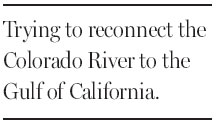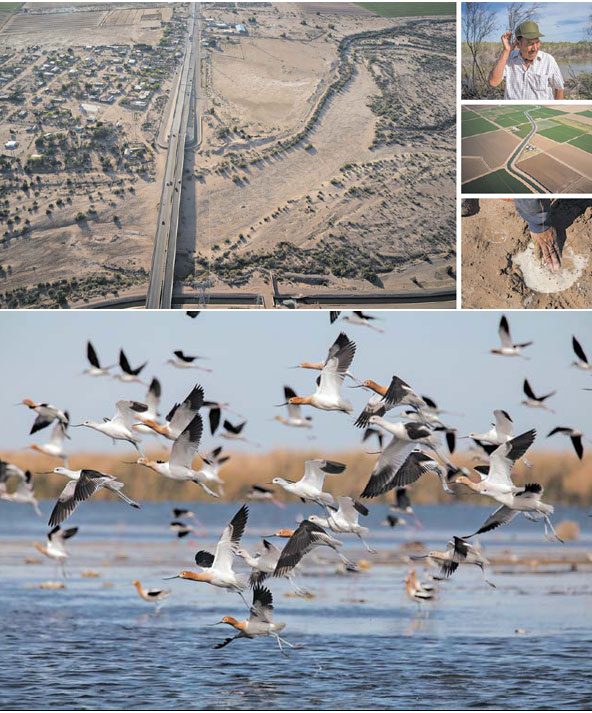Relief promised for Mexican delta
Updated: 2013-04-28 05:46
By Henry Fountain(The New York Times)
|
|||||||
|
La Cienega de Santa Clara, an important wetland that attracts migrating waterfowl, still gets some water from the Colorado. Clockwise, from top left, a dry Colorado River below the Morelos Dam; German Munoz, a local farmer; an irrigation canal near Mexicali; a native seedling being planted. Photographs by Fred R. Conrad / The New York Times |
Cucapa EL Mayor, Mexico - German Munoz looked out at the river before him and talked about the days when dolphins swam here, 90 kilometers from the sea.
"The wave made noise like a train," he said, describing the tides that would roll up the Colorado River from the Gulf of California. "There would be all kinds of fish jumping, very happy. And then the dolphins would come, chasing the fish."
That was in the 1950s, when the Colorado still flowed regularly to the gulf, washing sand and silt down from the Rocky Mountains to form a vast and fertile delta. In the last half-century, thanks to dams that throttled the Colorado and diverted its water to fuel the rise of the American West, the river has effectively ended at the Mexican border. The Colorado delta, once a lush network of freshwater and marine wetlands and meandering river channels and a haven for fish, migrating birds and other wildlife, is largely a parched wasteland.
In 1963, the last of the big Colorado dams, the Glen Canyon, began impounding water 1,100 kilometers upstream. "The river doesn't come here anymore," Mr. Munoz said.
But now there is reason for some optimism. An amendment to a seven-decades-old treaty between the United States and Mexico, called Minute 319, will send water down the river once again and support efforts to restore native habitat and attract local and migratory wildlife.
Although the amounts for the delta will be a trickle compared with the huge volumes siphoned off for cities, farms and industries, the amendment also calls for a larger one-time release of water that will mimic the once-common floods that rejuvenated the delta every spring, scouring out sediment and old vegetation and opening up areas for new vegetation to thrive. During this pulse flow, the Colorado should once again reach the sea.
"The new agreement will definitely help to restore the Colorado," said Efrain Nieblas, director of the environmental protection agency for the state of Baja California.
In the tidal estuary at the northern end of the gulf, the influx of fresher water will reduce salinity, aiding members of the indigenous Cucapa community and others who fish for gulf corvina and shrimp. "It's really important to connect the river with the ocean," Mr. Nieblas said.

The delta will never be like it was before the dams - for one thing, much of the river's main channel, the so-called riparian corridor, is now hemmed in by irrigated farmland - and Mr. Munoz surely will not see dolphins frolicking past his door again. But American and Mexican conservation groups say the agreement is a good first step.
"We'd been working hard for many years to have something like this," said Francisco Zamora, director of delta projects at the Sonoran Institute, which is based in Tucson. "We know it works. You add a little bit of water, and the trees will grow."
The goal is to restore about 900 hectares up and down stream over the five years of the agreement, at a cost of $8.5 million.
About 90 percent of the Colorado's annual flow of roughly 18 trillion liters goes to California, Arizona and the five other Western states. Under the 1944 treaty, Mexico is guaranteed almost two trillion liters. That water reaches the border at Morelos Dam, the last on the river, where it takes a sharp right turn into canals for delivery to Mexican farms and cities.
Usually, no water goes through the dam and down the riparian corridor. There is Colorado water in parts of the delta; it just gets there in roundabout ways. To the east of the river channel, La Cienega de Santa Clara, a 4,800-hectare wetland that is a stopover for migrating waterfowl, is fed by water that drains from irrigated cotton fields in Arizona.
But more water is needed, and it must come down the corridor. The river must flow.
As part of the agreement, conservation groups pledged to provide the water for the base flow, roughly 13 billion liters a year, by buying unused water rights from Mexican farmers. The water will be used to irrigate plantings and to raise the water table along the corridor to enable the water-hungry cottonwoods and willows to survive.
The idea is not to cut amounts being used by farms and cities, said Francisco Bernal, director of the Mexicali office of the International Boundary and Water Commission, but to save water through conservation improvements, some of which will be paid for by water districts in the United States in return for some of Mexico's water.
"We want to conserve enough water to share with the environment," he said.
Mr. Zamora said there would be social benefits, too.
"People here in Mexicali, sometimes they don't even know there's a river, because they don't see it," he said. "So it's really the process of reconnecting people with the river."
The New York Times
(China Daily 04/28/2013 page11)
